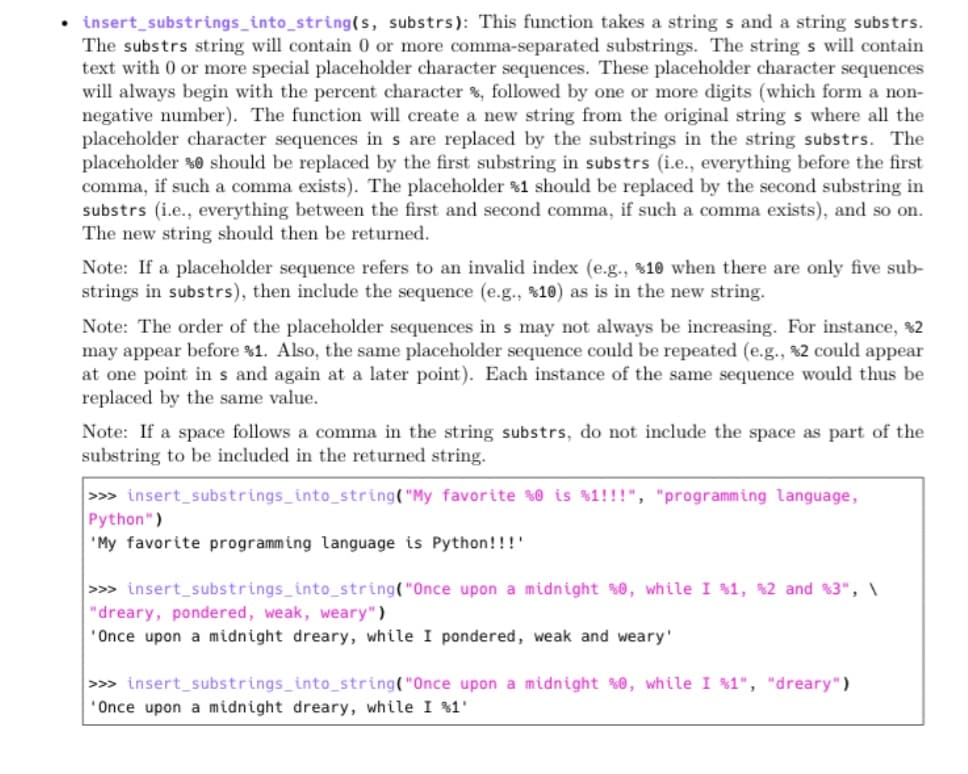• insert_substrings_into_string(s, substrs): This function takes a string s and a string substrs. The substrs string will contain 0 or more comma-separated substrings. The string s will contain text with 0 or more special placeholder character sequences. These placeholder character sequences will always begin with the percent character %, followed by one or more digits (which form a non- negative number). The function will create a new string from the original string s where all the placeholder character sequences in s are replaced by the substrings in the string substrs. The placeholder %0 should be replaced by the first substring in substrs (i.e., everything before the first comma, if such a comma exists). The placeholder 1 should be replaced by the second substring in substrs (i.e., everything between the first and second comma, if such a comma exists), and so on. The new string should then be returned.
• insert_substrings_into_string(s, substrs): This function takes a string s and a string substrs. The substrs string will contain 0 or more comma-separated substrings. The string s will contain text with 0 or more special placeholder character sequences. These placeholder character sequences will always begin with the percent character %, followed by one or more digits (which form a non- negative number). The function will create a new string from the original string s where all the placeholder character sequences in s are replaced by the substrings in the string substrs. The placeholder %0 should be replaced by the first substring in substrs (i.e., everything before the first comma, if such a comma exists). The placeholder 1 should be replaced by the second substring in substrs (i.e., everything between the first and second comma, if such a comma exists), and so on. The new string should then be returned.
C++ Programming: From Problem Analysis to Program Design
8th Edition
ISBN:9781337102087
Author:D. S. Malik
Publisher:D. S. Malik
Chapter7: User-defined Simple Data Types, Namespaces, And The String Type
Section: Chapter Questions
Problem 8PE: Write a program that reads in a line consisting of a students name, Social Security number, user ID,...
Related questions
Question
Please do not use replace or any other string method

Transcribed Image Text:insert_substrings_into_string(s, substrs): This function takes a string s and a string substrs.
The substrs string will contain 0 or more comma-separated substrings. The string s will contain
text with 0 or more special placeholder character sequences. These placeholder character sequences
will always begin with the percent character %, followed by one or more digits (which form a non-
negative number). The function will create a new string from the original string s where all the
placeholder character sequences in s are replaced by the substrings in the string substrs. The
placeholder %0 should be replaced by the first substring in substrs (i.e., everything before the first
comma, if such a comma exists). The placeholder %1 should be replaced by the second substring in
substrs (i.e., everything between the first and second comma, if such a comma exists), and so on.
The new string should then be returned.
Note: If a placeholder sequence refers to an invalid index (e.g., %10 when there are only five sub-
strings in substrs), then include the sequence (e.g., %10) as is in the new string.
Note: The order of the placeholder sequences in s may not always be increasing. For instance, %2
may appear before %1. Also, the same placeholder sequence could be repeated (e.g., %2 could appear
at one point in s and again at a later point). Each instance of the same sequence would thus be
replaced by the same value.
Note: If a space follows a comma in the string substrs, do not include the space as part of the
substring to be included in the returned string.
>>> insert_substrings_into_string("My favorite %0 is %1!!!", "programming language,
Python")
'My favorite programming language is Python!!!'
>>> insert_substrings_into_string("Once upon a midnight %0, while I %1, %2 and %3", \
"dreary, pondered, weak, weary")
'Once upon a midnight dreary, while I pondered, weak and weary'
>>> insert_substrings_into_string("Once upon a midnight %0, while I %1", "dreary")
'Once upon a midnight dreary, while I %1'
Expert Solution
This question has been solved!
Explore an expertly crafted, step-by-step solution for a thorough understanding of key concepts.
This is a popular solution!
Trending now
This is a popular solution!
Step by step
Solved in 2 steps with 1 images

Recommended textbooks for you

C++ Programming: From Problem Analysis to Program…
Computer Science
ISBN:
9781337102087
Author:
D. S. Malik
Publisher:
Cengage Learning

C++ Programming: From Problem Analysis to Program…
Computer Science
ISBN:
9781337102087
Author:
D. S. Malik
Publisher:
Cengage Learning